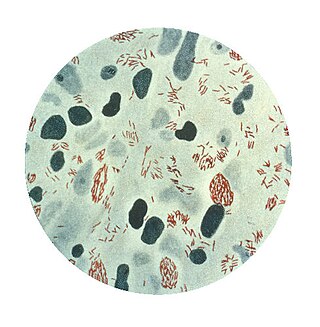
Mycobacterium tuberculosis, also known as Koch's bacillus, is a species of pathogenic bacteria in the family Mycobacteriaceae and the causative agent of tuberculosis. First discovered in 1882 by Robert Koch, M. tuberculosis has an unusual, waxy coating on its cell surface primarily due to the presence of mycolic acid. This coating makes the cells impervious to Gram staining, and as a result, M. tuberculosis can appear weakly Gram-positive. Acid-fast stains such as Ziehl–Neelsen, or fluorescent stains such as auramine are used instead to identify M. tuberculosis with a microscope. The physiology of M. tuberculosis is highly aerobic and requires high levels of oxygen. Primarily a pathogen of the mammalian respiratory system, it infects the lungs. The most frequently used diagnostic methods for tuberculosis are the tuberculin skin test, acid-fast stain, culture, and polymerase chain reaction.

Mycobacterium is a genus of over 190 species in the phylum Actinomycetota, assigned its own family, Mycobacteriaceae. This genus includes pathogens known to cause serious diseases in mammals, including tuberculosis and leprosy in humans. The Greek prefix myco- means 'fungus', alluding to this genus' mold-like colony surfaces. Since this genus has cell walls with Gram-positive and Gram-negative features, acid-fast staining is used to emphasize their resistance to acids, compared to other cell types.

Mycobacterium leprae, is one of the two species of bacteria that cause Hansen’s disease (leprosy), a chronic but curable infectious disease that damages the peripheral nerves and targets the skin, eyes, nose, and muscles.
The Timpe and Runyon classification of nontuberculous mycobacteria based on the rate of growth, production of yellow pigment and whether this pigment was produced in the dark or only after exposure to light.

Mycobacteroides abscessus is a species of rapidly growing, multidrug-resistant, nontuberculous mycobacteria that is a common soil and water contaminant. Although M. abscessus most commonly causes chronic lung infection and skin and soft tissue infection (SSTI), it can also cause infection in almost all human organs, mostly in patients with suppressed immune systems. Amongst NTM species responsible for disease, infection caused by M. abscessus complex are more difficult to treat due to antimicrobial drug resistance.
Mycobacterium africanum is a species of Mycobacterium that is most commonly found in West African countries, where it is estimated to cause up to 40% of pulmonary tuberculosis. The symptoms of infection resemble those of M. tuberculosis.
Mycobacterium botniense is a slowly growing Mycobacterium, which produces a yellow pigment. It was first isolated from a stream of water. M. botniense is most closely related to Mycobacterium xenopi. Etymology: botniense; of Botnia, referring to the Latin name of the province of Finland from which the isolation was made.
Mycobacterium branderi is a slowly growing, nonchromogenic Mycobacterium first isolated from patients in Finland. Etymology: of Brander, referring to Eljas Brander, the former head of the Tuberculosis Laboratory of the National Public Health Institute, Finland, who collected the strains.
Mycobacterium brumae is a rapidly growing environmental mycobacterial species identified in 1993. Aside from one 2004 report of a catheter related bloodstream infection no other infections by this organism have been reported. It was first isolated from water, soil and one human sputum sample in Spain.
Mycobacterium canariasense is a rapidly growing, non-pigmented mycobacterium first isolated from blood samples obtained from 17 patients with febrile syndrome. Etymology: canariasense; referring to the Latin adjective of the Spanish islands where all strains were isolated.
Mycobacterium chubuense is a species of the phylum Actinomycetota, belonging to the genus Mycobacterium.
Mycobacterium gordonae is a species of Mycobacterium named for Ruth E. Gordon. It is a species of the phylum Actinomycetota, belonging to the genus Mycobacterium.
Mycobacterium avium complex is a group of mycobacteria comprising Mycobacterium intracellulare and Mycobacterium avium that are commonly grouped because they infect humans together; this group, in turn, is part of the group of nontuberculous mycobacteria. These bacteria cause Mycobacterium avium-intracellulare infections or Mycobacterium avium complex infections in humans. These bacteria are common and are found in fresh and salt water, in household dust and in soil. MAC bacteria usually cause infection in those who are immunocompromised or those with severe lung disease.
Mycobacterium vanbaalenii is a rapidly growing mycobacterium that can use polycyclic aromatic hydrocarbons. It was first isolated from petroleum-contaminated estuarine sediments and has been shown by 16S rRNA gene sequencing to be closely related to Mycobacterium aurum and Mycobacterium vaccae. M. vanbaalenii has potential use in the bioremediation of polycyclic aromatic hydrocarbon contaminated environmental sites. Etymology: vanbaalenii of Van Baalen, in memory of Dr Chase Van Baalen, late Professor at The University of Texas Marine Science Institute, Port Aransas Marine Laboratory, Port Aransas, TX, USA.
Mycobacterium pyrenivorans is a scotochromogenic, rapidly growing mycobacterium, first isolated from an enrichment culture obtained from soil that was highly contaminated with polycyclic aromatic hydrocarbons (PAHs). The soil sample was collected on the site of a former coking plant at Ubach-Palenberg, Germany. Etymology: pyrenivorans; digesting pyrene.
The Mycobacterium tuberculosis complex is a genetically related group of Mycobacterium species that can cause tuberculosis in humans or other animals.
Mycolicibacter nonchromogenicus is an infectious species of bacteria.
Mycobacterium parascrofulaceum is a species of Mycobacterium.
Mycolicibacterium aichiense is a species of bacteria from the phylum Actinomycetota that was first isolated from soil and from human sputum. It produces pigments when grow in the dark and grows rapidly at 25–37 °C on Ogawa egg medium or Sauton agar medium.



